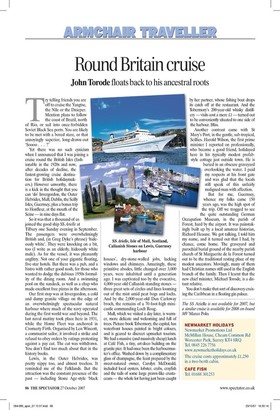Round Britain cruise
John Torode floats back to his ancestral roots Try telling friends you are off to cruise the Yangtse, the Nile or the Dnieper. Mention plans to follow the coast of Brazil, north of Rio, or sail into once-forbidden Soviet Black Sea ports. You are likely to be met with a bored stare, or that annoyingly superior, long-drawn-out `S0000 . . . ?'
Yet there was no such cynicism when I announced that I was joining a cruise round the British Isles (fashionable in the 1920s and now, after decades of decline, the r fastest-growing cruise destination for British holidaymakers.) However unworthy, there is a kick in the thought that you can 'do' Invergordon, the Outer Hebrides, Mull, Dublin, the Scilly Isles, Guernsey, plus a bonus trip to Honfleur, at the mouth of the Seine — in nine days flat.
So it was that a thousand of us joined the good ship SS Arielle at Tilbury one Sunday evening in September. The passengers were overwhelmingly British and, (in Greg Dyke's phrase) 'hideously white'. They were knocking on a bit, too (I write as an elderly, hideously white male). As for the vessel, it was pleasantly unglitzy. Not one of your gigantic floating, five-star hotels. But there was a pub, and a bistro with rather good nosh, for those who wanted to dodge the dubious 1950s formality of the dining room. And a swimming pool on the sundeck, as well as a chap who made excellent free pizzas in the afternoon.
Our first stop was at Invergordon, a cold and damp granite village on the edge of an overwhelmingly spectacular natural harbour where much of the navy operated during the first world war and beyond. The last naval mutiny took place here in 1931, while the Home Fleet was anchored in Cromarty Firth. Organised by Len Wincott, a communist sailor, it involved a strike and refusal to obey orders by ratings protesting against a pay cut. The cut was withdrawn. You don't find too much about that in the history books.
Lewis, in the Outer Hebrides, was pretty nippy too, and almost treeless. It reminded me of the Falklands. But the attraction was the constant presence of the past — including Stone Age-style 'black houses', dry-stone-walled jobs, lacking windows and chimneys. Amazingly, these primitive abodes, little changed over 3,000 years, were inhabited until a generation ago. I was captivated too by the evocative, 4,000-year-old Callanish standing stones — three great sets of circles and lines looming out of the mist amid peat bogs and lochs. And by the 2,000-year-old Dun Carloway broch, the remains of a 70-foot-high minicastle commanding Loch Roag.
Mull, which we visited a day later, is warmer, more delicate and welcoming and full of trees. Picture-book Tobermory, the capital, has waterfront houses painted in bright colours, and is geared to discreet upmarket tourism. We had a massive (and massively cheap) lunch at Café Fish, a tiny, art-deco building on the granite pier. It had once been the harbourmaster's office. Washed down by a complimentary glass of champagne, the feast prepared by the sweet-natured owner, Carolyn McDonald, included local oysters, lobster, crabs, crayfish and the tails of some large prawn-like crustaceans — the whole lot having just been caught by her partner, whose fishing boat drops its catch off at the restaurant. And the Tobermory's 200-year-old whisky distillery — visits cost a mere £1 — turned out to be conveniently situated to one side of the harbour. Bliss.
Another contrast came with St Mary's Port, in the gentle, sub-tropical, Scillies. Harold Wilson, the first prime minister I reported on professionally, who became a good friend, holidayed here in his typically modest prefabstyle cottage just outside town. He is buried in an obscure graveyard overlooking the water. I paid my respects at his front gate and was glad that the locals still speak of this unfairly maligned man with affection.
But for me, Guernsey, whence my folks came 150 years ago, was the high spot of the trip. Off we trogged to see the quite outstanding German Occupation Museum, in the parish of Forest, hard by the airport. It was painstakingly built up by a local amateur historian, Richard Heaune. We got talking, I told him my name, and it turned out that I had, by chance, come home. The graveyard and parochial burial ground of the nearby parish church of St Marguerite de la Forest turned out to be the traditional resting place of my modest ancestors. Movingly, many of them had Christian names still used in the English branch of the family. Then I learnt that the new chief minister, Michael Torode, is a distant relative.
You don't make that sort of discovery cruising the Caribbean in a floating gin palace.
The SS Arielle is not available for 2007, but a similar cruise is available for 2008 on-board MT/Marco Polo.


































































 Previous page
Previous page